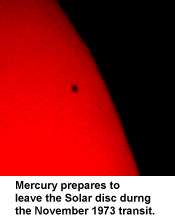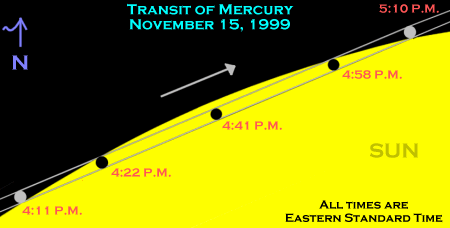

The November 15, 1999 Transit of Mercury
On November 15, 1999, Earth, the planet Mercury and the Sun will be in almost a straight line. This will allow everyone on the daytime side of the Earth to see Mercury move across the face of the Sun. This event is called a transit, since the disc of Mercury will cross or transit the face of the Sun.
Both our Earth and Mercury are moving in the same direction,
counterclockwise as viewed downward from the north. Mercury is in an orbit
that is much closer to the Sun, so it moves faster. From our viewpoint,
speedy Mercury will approach the Sun from its west side. But Mercury and
the Earth are not quite in the same orbital plane. The orbit of Mercury
is tilted seven degrees from that of the Earth. This tilt usually takes
Mercury above or below the Sun as seen from the Earth.
But there are two times a year that if Mercury happens to pass the Sun, it will crosses in front of the Sun. One of these times is around May 8, the other around November 10. If the transit occurs on either of these dates, Mercury will travel across the center of the Sun's disc. The longer before or after those dates that a transit occurs, the farther Mercury will be from the center of the Sun. Our November 15 event will occur just at the end of the November transit "window". As such, Mercury will be very near the north edge of the Sun during the transit. If Mercury had taken a day longer to pass the Sun, there would not be a transit at all!
The transit will be visible everywhere on Earth that the Sun is visible during the event. Since it is almost winter in the northern hemisphere, the north-polar areas will be in darkness and will not see the event. It will be night in Europe, Africa and most of Asia. Japan will see the event at sunrise. Australia, Antarctica, North and South America will have a ringside seat for the transit.
While transits of Mercury occurs about once every eight years, only half of the Earth sees each transit. This makes a transit a rather rare event. The last one visible from North America was November 10, 1973. The last one visible anywhere on the Earth was November 13, 1993.
This transit is even rarer. While Mercury will be completely on the Sun's disc as viewed from the northern hemisphere, Australians will never see Mercury completely on the solar disc. In this partial transit zone Mercury will appear to skim along the edge of the Sun appearing as a notch in the north-northeast edge of the Sun. The transit will be very short in this area, lasting only about forty-six minutes. Only the southern three-quarters of Australia, Antarctica, and the southern Pacific are in the partial transit zone. The last partial transit was May 11, 1937 and was only visible in the southern part of the eastern hemisphere.
No matter where you are, Mercury will appear to traverse only a short section of the northern end of the Sun, making the transit last an unusually short time. The transit will take only about an hour. Mercury will enter the Sun's disc around 4:11 EST at the north-northwestern edge of the Sun. It will take a little over eleven minutes for Mercury to completely enter the Sun's disc.
Mercury will now appear as a black dot against the bright surface of the Sun. Mercury's orbital motion will slowly take it across the northern edge of the Sun. Around 4:58 EST, Mercury will reach the edge of the Sun again. It will take another eleven and a half minutes for the planet to move off the face of the Sun, ending the transit.

CAUTION: NEVER LOOK DIRECTLY AT THE SUN EITHER WITH OR WITHOUT OPTICAL AID! You will be permanently blinded unless you have the correct solar filter.
Mercury is a physically small planet, only three thousand miles in diameter, compared to Earth's almost eight thousand. During the transit, Mercury will be visible as a tiny dot near the Sun's northern edge. The planet will be ten seconds of arc in diameter, only one-half of one percent of the solar disc. This tiny size will require substantial magnification to see the Mercury's disc against the Sun. A two-inch-diameter telescope is probably the minimum required to see the transit.
In addition to the telescope, you will need a full-aperture solar filter. This is a filter that reduces the brightness of the Sun by a factor of 10,000. They are placed over the front of telescope, covering the entire front aperture. This keeps the Sun's heat from even entering the telescope. If you have a small filter that goes over the eyepiece, throw it out: the Sun's heat could potentially crack the filter while you are looking through it. This would allow the full heat of the Sun, concentrated by the telescope and eyepiece to reach your eye. You will suffer extensive eye damage, so only use the full-aperture solar filter or do not look at the Transit.
There will not be another transit of Mercury visible from
western North America until 2016, so don't miss this one!
| Time Zone | Transit Starts | Entry Finished | Middle | Exit Begins | Transit Ends |
| Eastern | 4:11 p.m. | 4:22 p.m. | 4:41 p.m. | 4:58 p.m. | 5:10 p.m. |
| Central | 3:11 p.m. | 3:22 p.m. | 3:41 p.m. | 3:59 p.m. | 4:10 p.m. |
| Mountain | 2:11 p.m. | 2:23 p.m. | 2:41 p.m. | 2:59 p.m. | 3:10 p.m. |
| Pacific | 1:12 p.m. | 1:23 p.m. | 1:41 p.m. | 1:59 p.m. | 2:10 p.m. |
| Alaskan | 12:12 p.m. | 12:23 p.m. | 12:41 p.m. | 12:59 p.m. | 1:11 p.m. |
| Position Angle |
33° | 29° | 23° | 16° | 13° |
Matt Ganis
Astronomical League
Return to Astronomical League Home Page.
This page is maintained by Matt Ganis for the Astronomical League. Comments, corrections, and suggestions can be addressed to webmaster@astroleague.org. This page last updated November 1, 1999.